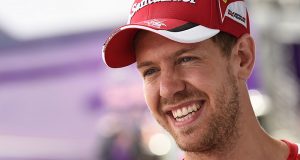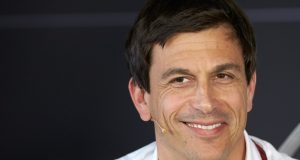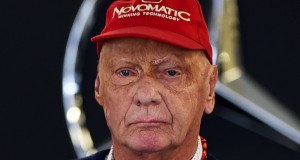Questions and answers with Tonio Liuzzi, Adrian Sutil, Otmar Szafnauer and Mark Smith.
Image Gallery from the launch and a nice video presentation.
- VJM03 – Revelation of Force
Tonio Liuzzi Q&A: ‘I am approaching it from a different mentality’
It’s finally a chance to get a full race season under your belt for the first time since 2007. What are your thoughts on this?
After one and a half years in a test role, I feel really prepared, both physically and mentally for a full race season. My objective is to be as strong and consistent as possible and give good feedback to the team to help them improve. For sure scoring points as many times as I can is going to be the key and you never know, perhaps we can get something more as well if everything comes together.
How would you review your five races in 2009? What did you learn?
It was a great opportunity to learn the tracks and then get back to the rhythm of a F1 car. I was a bit disappointed with some races, but we knew that the car would suit Monza much better than the other types of circuit. We had a bit of bad luck as well, like qualifying in Brazil when I aquaplaned off. Although it was difficult to score points, it was important for me to show that when the car is performing well I am ready to bring the results in and I’m always the same, fast competitive driver I’ve always been. It was a good warm up for 2010.
Do you feel this time round as a racer you’re approaching it differently?
In Force India I feel really good, the atmosphere is great and the team works well together. Even when I was in a difficult position last year as a test driver they were very supportive and I’ve built a good strong relationship with them. I feel like I’m in a family and for sure much better environment than I have been in the past. This year is a new start for me. I’m a different person from two years ago and I am approaching it from a different mentality. It’s a different Tonio and I’m looking forward to what can come. I’m still young and have a lot of time in front of me so I just want to prove what I can do.
Do you feel confident in the VJM03?
I have to say that the team, looking at what we did last year, has done a fantastic job. They never stopped working on the 2009 car to push right to the end, but have been flat out for 2010 as well. I am really confident in the work they have done over the winter and we’ve built a car that can regularly be in the points. That’s also my aim, plus to be more consistent and competitive throughout the whole season.
With the new teams coming in, Force India won’t be the smallest team on the grid any more. Is this an advantage?
Yes, this is an advantage for us as we know how to operate on smaller levels that the bigger teams will have to get used to, while the new teams have a tough job to do. I think it will be a good season for us.
Adrian Sutil Q&A: ‘We are just focusing on the racing’
2009 was a transitional year for the team, and you scored your best result in F1 to date. How would you sum up this year?
2009 was a really important year. I was very close to scoring points in a lot of races and, frustratingly, something always happened. So when we got to Monza, it was a pretty perfect weekend. I scored my first front row, my first points since 2007 and it gave me a lot of extra confidence. I was very happy when the success came and it was for sure a big moment in my career, the turning point. It’s really different to start from the front row and race at the front and I feel it has helped me to grow. I know I need to follow it up this year now.
How do you feel going into this year?
I hope we will have a good season and I am pretty confident we will. We have had a good winter and a very good development programme so expectations are high. The car looks great, we did a positive step with the wind tunnel simulations but let’s test and see where we are. I know we need to perform well and from my side I have tried to be perfectly prepared.
What will your aims be this year, how do you intend to build on last year?
2010 is a really important season and we are very optimistic about going well. When you start a season you always want it to be better than the previous one and I think this year it’s important to be consistent from the first race. It’s the first time we have been completely on schedule so I feel this will be the first season when I can show from the beginning to the end what is possible on the car and what I can do. I’d like to be in the midfield and be competitive from Bahrain.
This is now your fourth season with the Silverstone-based team. What does this stability mean for you?
I feel really good in the team, it’s like family for me as they know me very well, they know how I work and my strengths and weaknesses. With that kind of relationship they can really get the things that suit me and I have confidence in them to do it. At the end of last season I felt very good and it was hard to find a better option for 2010. Over the past four years we have of course seen many different changes but when Vijay took over in 2007 it was a step in the right direction. He’s committed to go for it and he has his goals. Right now we’re looking really good, we’ve sorted out all the issues and this winter has been a consistent working situation so it’s a big advantage. It’s nice to be one of the few teams who have stability now and can just focus on the racing.
The competition is very tough this year, with new teams and more world champions in the field than in previous years. What are your thoughts on this?
The competition of course will be really tough with four world champions in the field now – of course Lewis and Jenson in McLaren, Fernando in the Ferrari and now Michael back in Mercedes. I have a lot of respect for all of them and I’m actually really excited about being on the same grid, but at the end of the day they are your competitors. You can’t hold them up as heroes or goals – when we’re racing they are people you need to beat. If you do go well against them it will really lift you so I’m looking forward to seeing how I do.
Mark Smith Q&A: ‘It’s been a lot smoother this year’
Some significant rule changes have made this a busy winter for all the F1 teams, although this year continuity in terms of engine and gearbox supply has been a boost for Force India.
Last winter Force India had to deal with a relatively late change of engine supplier and the switch to a McLaren gearbox. How much smoother have things been this time around?
It’s been a lot smoother. From the very beginning we designed the VJM03 in full knowledge of the engine and gearbox that we would be using for 2010, which gave us a significant advantage by comparison with respect to the same point in design time for VJM02. Fundamentally, key relationships are established and data is available to us much earlier. The result of this is a much smoother design and development process.
In 2010 there is no refuelling, the front tyres are narrower, and wheel covers are banned. Have those changes dominated your thoughts, or were there any other key issues?
In terms of the way the car was designed and their impact upon performance, it’s predominantly those three factors. The wheel covers were an aerodynamic device, so you take them off and develop around the new configuration. The refuelling ban however has had a significant impact upon a number of areas, such as the wheelbase, cooling system layout and the way the fuel system has to perform without fresh fuel going in every 20 laps or so. The narrower front tyres have a little bit of an aero implication, but primarily it’s a case of best predicting their on track performance because their characteristics appear on paper to be quite different to last year’s.
What sort of differences should we look for on the VJM03 compared to last year’s car?
It’s a natural progression in areas which seemed to have strong trends at the end of 2009, and in other areas it’s quite different. The back of the car is the area that has evolved most as everyone has had a year of experience with the double diffusers so we’ve all gone into 2010 much wiser to what we can do. There have been some refinements in that area and it’s formed part of the make-up of the car this time around, rather than being added very quickly, as happened at the beginning of last year. It’s natural now to design the car to take these devices. The gearbox is now a little bit easier to work around, and there are tweaks to make the diffuser potential bigger. So there are some notable differences.
What are the implications of the narrower front tyres?
The main implications are the way in which the new tyres will influence the balance requirements of the car in aerodynamic, mechanical and weight distribution terms. Whilst we have up front data for the tyres, it will only be after running the car on circuit that we will have the real understanding of how they interact with the car. Also, the range of fuel load carried on board the car in 2010 is significantly higher than it was in 2009 and this is expected to place further demands on tyre management throughout the race. All of this will mean that there will be a premium placed upon looking after the tyres and some driver / car combinations are likely to derive an advantage from this.
How much effort went into calculating the optimum fuel tank size? Potentially if someone gets it wrong, they could be in trouble in high consumption races such as Montreal and Valencia.
A lot of effort went into this. Since the fuel cell size impacts upon many areas of design it was important to target the maximum requirement as accurately as we believed possible. Firstly, we undertook a thorough analysis of historical data and then modified that with the effect of factors such as increased fuel load and revised aero effects upon laptime and consequent fuel consumption. There was also good input from Mercedes in terms of their predictions for consumption.
The extra fuel has to go somewhere. To what extent has the chassis grown to accommodate it?
Maximum width of the fuel cell is limited by regulation so the main effect is for the chassis to have grown in length.
What are the implications of the heavy fuel load?
The implications on lap time are obviously very big – you are probably talking about up to five seconds. So the cars will certainly go a lot slower at the start of the race. It will be a lot more difficult for the drivers with a heavy load, and certainly our drivers weren’t around in the last era with no refuelling! Then you’ve got your brakes to manage as well. We have our methods of looking at how the brake cooling works, and the targets have been re-set for the fuel loads and energy predictions that we’ve had.
Last year you quickly abandoned the option for an adjustable front flap because incorporating it made it harder to keep up wing development. Will it be more important to have the system operational this year?
I think it’s potentially more important. No one really spoke about it much in the paddock last year, we didn’t get the impression it was a big boost for the drivers, so we were happy to do without it. But given that you’ve got the scenario where you’ve got to manage the car in a race now, it’s a good thing to have if you can. So we’re making efforts to ‘future proof’ it this year.
Overall, are you happy with the way everything has turned out?
We will only be in a position to answer that question once we have the first race under our belts. The development rates in Formula One were very high last year and this has largely been maintained over the winter design period. How this will manifest itself in relative terms between the teams remains to be seen.
Otmar Szafnauer Q&A: ‘I think stability does produce results’
Otmar Szafnauer joined Force India as Chief Operating Officer in October. We asked him for his thoughts on the team and its prospects for 2010.
You’ve been with the team for nearly four months now. What impressions have you gained?
I like the atmosphere in the team. With half the people of a big team we design a good car and the wind tunnel guys do a very good job in getting the numbers that are required. You just don’t have the time or resources available to waste, so you just get on with the job.
When you joined the team was in a very stable situation, and was enjoying some success on the track. Has that helped to make things very straightforward for you?
I think stability does produce results. That’s not to say you shouldn’t change and improve as clearly you should, but huge upheavals never help. If you can have stability with the right people pulling in the same direction, you’re much better off. Fortunately we have that here.
What improvements are already underway?
There are two big improvements from 2009. One has been the increase in our CFD [Computational Fluid Dynamics] resource, thanks to a new partnership with CRL in India, which has increased our capacity by five-fold. The other principal area has been the utilisation of the wind tunnel to a greater extent, almost 24 -7. Coupled together this has allowed us to take great steps forward. Last year Simon Roberts also instilled some very good processes and procedures that have also helped to refine our procedures, communications within the company and ultimately the decision making process. Simon did a great job in doing that, and I’m going to carry that forward.
Like Red Bull you missed the Valencia test, and instead you are shaking down the new car at Silverstone. What was the thinking behind that?
It was a strategic decision. By missing the first test, we can gain a little bit more development time – a little bit longer in the tunnel, a little bit longer thinking about what’s important on the car. It was just a trade-off decision. We completed a shakedown day, before the testing started that regains a little bit of what we’ve lost.
This year there is a Resource Restriction Agreement taking shape – how does that affect Force India?
There’s a step down in personnel allowed at races this year, as well as on external expenditure, but neither affect us at all. If we change nothing this year, we’ll be below both of the levels set whereas some other teams will have to come down. It is very much to our advantage as we are not having to learn any new skills or working operations procedures.
What are the big challenges that the team faces over the next year or two?
Our biggest challenge is to get the wind tunnel up to 24-7, and becoming efficient with our CFD capacity. For you to maximise your performance there are a thousand little things that you need to get right. This year the racing is going to be a bit different, with no refuelling, and it’s always good to have more money so you can do more development throughout the year!
You mentioned the changes in race strategy this year. Do you think that the team could gain from being quick on its feet and making the right calls?
Yes, especially early on in the year when people haven’t quite settled down yet. I think in F1 we’re all quick to learn, and quick to learn from each other. If we can make some good calls early on, that will help us.
You have kept the same drivers. What do they bring to the team?
Adrian is a great asset. He’s very talented, and he’s fast and fearless, and he’ll gain from the experience he now has. If Tonio can learn from last year, and his confidence is up knowing that he’s got a regular seat now, he has great potential.
Finally you have signed Paul di Resta as third driver. How do you see his role?
He’s a young driver with a lot of potential, and we’re going to work with him to maximise that potential. And that should be to the benefit of this team. He can help us in simulator testing, and he should be doing some Friday testing just to get familiar with the car and hone his skills. And then we’ll see about the future.
Source Force India F1
© RIF
 Racing In Focus Motorsport and Events Coverage | Racing News, Results, Photos.. from Formula 1, American Le Mans, NASCAR, IndyCar and Canadian racing
Racing In Focus Motorsport and Events Coverage | Racing News, Results, Photos.. from Formula 1, American Le Mans, NASCAR, IndyCar and Canadian racing













